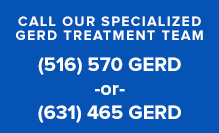Acid Reflux / GERD Treatment, New York
According to the International Foundation for Functional Gastrointestinal Disorders, nearly one third of Americans are affected by acid reflux disease or gastroesophageal reflux disease (GERD). This condition is caused by a weakness of the valve in the lower esophagus (called the Lower Esophageal Sphincter or LES) that is supposed to prevent acids from leaving the stomach. When the valve does not close properly, acid can rise up out of the stomach and lead to symptoms such as heartburn, regurgitation, or stomach discomfort.
 It is important to note that virtually everybody will experience acid reflux at some point in their lives. This is very different from GERD, which represents chronic acid reflux. Patients who experience acid reflux more than a few times per week over the course of several months, may have GERD.
It is important to note that virtually everybody will experience acid reflux at some point in their lives. This is very different from GERD, which represents chronic acid reflux. Patients who experience acid reflux more than a few times per week over the course of several months, may have GERD.
GERD should be treated as soon as possible because the stomach acid can erode the lining of the esophagus – a very painful and, if left untreated, dangerous condition. Eventually chronic acid reflux can lead to esophageal cancer.
Causes and Symptoms of GERD
There are many and varied causes of GERD. They can include genetic predispositions to the disease and environmental and lifestyle factors. Some of the most commons causes of GERD include:
- Obesity
- Eating spicy or fatty foods regularly
- Congenital weakness of the LES
- Drinking alcohol or smoking
- Certain medications
The symptoms of GERD are very obvious and can be diagnosed easily by a medical professional based on a consultation and reviewing medical history. They include:
- Chronic coughing
- Acidic taste in the mouth after eating
- Burning sensation in the chest, chest pain
- Discoloration of the teeth and bad breath
Some or all of the symptoms above can also be caused by other conditions, so visiting a qualified medical professional is the most important step to ensure an accurate diagnosis.
Surgical Treatment For GERD
Nissen Fundoplication
We treat these conditions using a procedure known as Nissen Fundoplication, using laparoscopy and robotic surgery. We use a laparoscope to view and evaluate the condition of the stomach and esophagus. The surgeon uses stitches to wrap a portion of the stomach around the end of the esophagus, tightening the esophagus and preventing stomach acids from rising. This treatment is usually performed in conjunction with a hiatal hernia repair.
LINX
For those patients that have not seen improvement with medication or are not happy with the side effects, as well as those who are not interested in the more invasive fundoplication option, a procedure known as LINX may be a good option. This minimally invasive, outpatient procedure requires a very short procedure time and patients may return to normal activities in just a few days. Learn more about LINX for GERD
